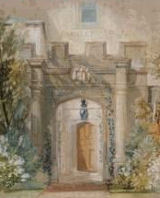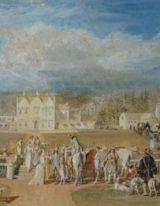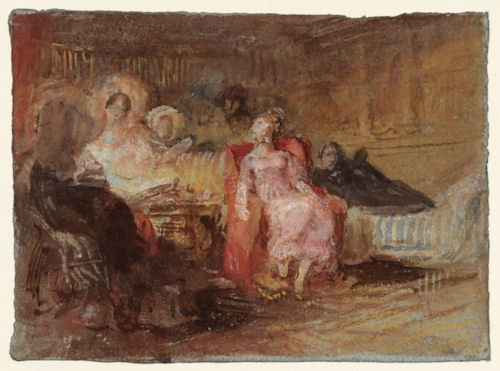




Theme. Characters. Plot. Aura. These are the elements that film makers make use of in order to translate a written work into film, sometimes adding to our appreciation of the original Novel (as in the case of the 1995 miniseries of Pride and Prejudice), and sometimes pointing out its failings, as the 1995 filmed version of Sense and Sensibility drew attention to the deficiencies and incoherencies of the Novel by inventing entirely new situations as well as embellishing the existing characters beyond recognition, particularly in its introductory stages. In fact, I have always quite enjoyed watching the beginning of 1995's Sense and Sensibility;
Sometimes, as with the latest version of Northanger Abbey, shown in early 2008 on North America's PBS stations, the facts have been changed and exaggerated, but the aura is left intact, and we come back to the half-forgotten Novel with increased interest. (The 1940 film version of Pride and Prejudice also contains a great deal of invention, particularly of dialogue, adding nothing whatever to our knowledge or enjoyment of the original Novel, except in the impact of one certain particular visual detail, and subtracting everything pertaining to the Novel's aura of intelligence and wit. But those objections have been raised in the main chapters of this website, and needn't be repeated here);
Film also makes it easier to judge the success or failure of a Novel to nudge our collective memory by way of Fairy Tale or Myth, as earlier described. In my opinion, the previously mentioned 2008 PBS version of Northanger Abbey succeeds quite nicely as Fairy Tale, while the similar PBS filmed version of Persuasion errs greatly in adding an inescapable undercurrent of bitterness to the story. It is a fact that a reader burns with righteous anger on behalf of courageous heroine Anne Elliot, but film makers should not do so when the strength of the Novel lies precisely in Anne's wry acceptance of her family members as they are, rather than as they should be. Perhaps they were trying to persuade us that here we may have a somewhat convincing resemblance to Myth?
If so, they were wrong. A story needs to be extremely powerful in order to aspire to the greatness of Myth, and Northanger Abbey and Persuasion are Austen's least weighty Novels. Actually, and it hardly seems credible, but the only Austen Novel that might possibly qualify as Myth is — Lady Susan, mainly because the [anti-]heroine, and her friend and confident as well, end by getting the outcome they both richly deserve.
As for the other Novels, what is the use of Fairy Tale apart from a necessary Happily Ever After?
I don't believe for a moment that any of the other films of Jane Austen Novels is as successful as the 1995 Pride and Prejudice miniseries in leading the viewer to reread and reassess the original Novel upon which the film has been based.
Perhaps that sentence should be redrafted. I do believe that the viewer of the 1995 film Sense and Sensibility who goes to the Novel looking for the sympathetic characters found in the film — Edward and Margaret, for example — will do a great deal of re-assessing, none of it complimentary to the Novel.
But reading the Novel Pride and Prejudice after watching the 1995 miniseries helps us to realise that Jane Austen's first and best work is the greatest romantic love story in English literature. And the factors that make it such a magnificent piece of writing, prevent its ever being filmed entirely successfully. Not if the film runs for ten hours, or thirty.
Of course I've written an entire webpage [Introduction – Fear and Loathing: The Filming of a Beloved Novel] for the Main Did Darcy Lie? Pride and Prejudice section and have no real reason to repeat myself in this present section devoted to the other Jane Austen Novels, all of which have their own film treatments to worry about.
As a general rule, a work of fiction is beloved by its readers to the extent that it succeeds in accessing that most simple and primitive of sources: our collective memory of the transformatory childhood journey of Fairy Tale, or the more static struggle against inexorable Fate in Myth. And, as often mentioned, one of the necessary conditions for inclusion in this Sandsifter Five collection is precisely the recognition that the work shows an unmistakeable provenance from Fairy Tale or from Myth.
I've proven to my own satisfaction in my six-part section Fairy Tale and Myth that Pride and Prejudice achieves with brilliance the goal of identification with the Fairy Tale East of the Sun and West of the Moon, and far less successfully with the Myth Amor and Psyche. In the final webpage of the section, I point out that a man will tell you that the plot of all three literary works discussed in that section — which is to say, English Novel, Norwegian Fairy Tale and Roman Myth — can be summed up in nine words:—
But that women's minds work in more subtle fashion; and we understand that reducing these three stories to their essence requires discerning seven necessary plot elements, which are duly described therein, with helpful illustrations that include:—
Amor and Psyche and Pride and Prejudice
 Wikipedia, The Kiss (1907-08
Wikipedia, The Kiss (1907-08
Gustav Klimt (1862-1918)
Oil on canvas: 65-3/4 x 75-5/8 inches
Osterreichische Galerie Belvedere, Vienna
 Cupid and Psyche (1873)
Cupid and Psyche (1873)
John Roddam Spencer Stanhope (1829-1908)
From Rutgers Website, Images of Cupid and Psyche
Oil on canvas: 40 x 35 cm
Location of original?
Each of Jane Austen's remaining Novels will be examined in their appropriate webpages as regards Fairy Tale and Myth.
It's said (by Randy Newman on the subject of unreliable narrators) that you learn a person's character by what he chooses to lie about. But it may be equally instructive to study how realistically an author organises his or her material in order to give a necessary happy ending to a romantic Novel.
It's hard to imagine a more confident outlook on the future than that possessed by its heroine at the end of Pride and Prejudice. Other than freedom from a loathed and despised mother (and mother-in-law, insofar as Darcy is concerned), Elizabeth seems to make no particular demands in order to live happily ever after. Bolstered by frequent visits from her beloved aunt and uncle Gardiner, sister Jane, and father Mr. Bennet — as well, of course, by the continued love of Mr. Darcy — she is ready to meet any and all challenges, and challengers. We feel safe in assuming that Mr. Darcy also views the future with far less dread than when faced with a marriage that includes Lady Catherine de Bourgh as a mother-in-law highly unlikely to be banished from the scene as readily as the overawed Mrs. Bennet.
In fact there is only one possible dark cloud on the horizon, which I intend to deal with in the final chapter of the main web page.
The prospects for happiness of Sense and Sensibility's Elinor Dashwood are of a different kind, depending on happenstance rather than mastery. So long as neither she, nor hero Edward, nor sister Marianne, are called upon to make the slightest effort in order to extricate themselves from their various quandaries; so long as everything occurs as a result of the actions of others, it seems then, and only then, are the participants in the Novel free to acknowledge themselves entitled to contentment.
Judging from the fact that this Novel was accepted before the earlier written and offered for publication Pride and Prejudice, it appears that a theme of passive waiting was considered by publishers of the period to be the proper mode of conduct for men as well as women.
And Mansfield Park? No mass murderer armed with machine gun was ever as successful in removing from the scene almost everyone present at the beginning of the Novel, in order that the perfect Fanny Price be enabled to continue unopposed in her life's work of making herself acknowledged as morally superior to everyone else in the world — not excluding the seemingly adored Edmund.
I've left the endings of the other Novels to their respective webpages.
________________________
Details of and links to all Austen-Novel Pictures are found in the Pictures 3B webpage.
This Page:— Pride
and Prejudice Part Three: Film, Fairy Tale, and Happily Ever After
 JMW Turner, exhibited 1798
JMW Turner, exhibited 1798
Title: Refectory of Kirkstall Abbey, Yorkshire, exhibited 1798
Medium: Graphite and watercolour on paper
Dimensions: Support 448 x 651 mm
Collection: The Trustees of Sir John Soane's Museum
Turner Worldwide, Reference TW 0528, Wilton 234
 JMW Turner, 1815
JMW Turner, 1815
Title: Front Door and Porch, Farnley
Medium: Bodycolour on paper
Dimensions: unconfirmed 268 x 320 mm
Private Collection, Turner Worldwide
Reference: TW0237, Wilton 584
 JMW Turner, circa 1818
JMW Turner, circa 1818
Title: Farnley in the Old Time
Medium: Bodycolour on paper
Dimensions: unconfirmed 278 x 393 mm
Private Collection, Turner Worldwide
Reference: TW0262, Wilton 629
 JMW Turner, 1827
JMW Turner, 1827
The Lady in Pink: Conversation in the White Library 1827
Medium: Gouache and watercolour on paper;
Dimensions: Support 141 x 194 mm
Collection: Tate, Accepted by the nation as part of the Turner Bequest 1856
View by appointment at Tate Britain's Prints
and Drawings Room
Reference D22688
________________________